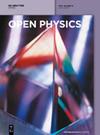颗粒形状和雷诺数对加热管中纳米流体传热特性的 CFD 分析
IF 1.8
4区 物理与天体物理
Q2 PHYSICS, MULTIDISCIPLINARY
引用次数: 0
摘要
各种纳米粒子已被用于提高纳米流体在加热管中的传热特性(HTC)。使用不同形状的相同纳米粒子会对 HTC 产生重大影响。本研究采用田口方法,对颗粒形状(砖状和板状)和雷诺数(Re)(4,500、6,000、7,500 和 9,000)对加热管中纳米流体的 HTC 的影响进行了计算流体动力学(CFD)分析。选择传热系数、努塞尔特(Nu)数、性能评价标准和平均静压降作为 HTC。根据 L8 正交阵列,在 ANSYS Fluent 软件中对 1% Fe3O4 纳米流体进行了 CFD 分析。粒子形状和 Re 数分别被选为第一和第二因子。信号/噪声分析用于确定每个因子的最佳水平和对 HTC 的影响方向,而方差分析则用于确定各因子的重要程度和影响比例。研究结果表明,与布里克纳米粒子相比,含有板状纳米粒子的纳米流体对传热系数的影响更大。虽然 Re 数的增加会导致传热系数、Nu 数和平均静压降的增加,但对性能评估标准没有任何影响。本研究得出的结果可作为实验研究的指导。本文章由计算机程序翻译,如有差异,请以英文原文为准。
CFD analysis of particle shape and Reynolds number on heat transfer characteristics of nanofluid in heated tube
Various nanoparticles have been used to increase the heat transfer characteristics (HTC) of nanofluids in the heated tube. The use of various shapes of the same nanoparticle can have major impact on the HTC. In this study, computational fluid dynamics (CFD) analysis of the impact of particle shape (Brick and Platelet) and Reynolds (Re) number (4,500, 6,000, 7,500, and 9,000) on the HTC of nanofluid in the heated tube was carried out in accordance with Taguchi method. Heat transfer coefficient, Nusselt (Nu) number, performance evaluation criteria, and average static pressure drop were chosen as HTC. CFD analyses for 1% Fe3 O4 nanofluids in ANSYS Fluent software were performed in accordance with L8 orthogonal array. Particle shape and Re number were selected as the first and second factors, respectively. Signal/noise analysis was used to decide optimum levels and impact direction on HTC for each factor, whereas analysis of variance was implemented to define the importance levels and percentage impact ratios of the factors. According to the results obtained from the study, the nanofluids with platelet nanoparticles have a higher impact on the heat transfer coefficient compared to Brick nanoparticles. Although the increase in the Re number causes an increase in the heat transfer coefficient, Nu number, and average static pressure drop, it does not have any effect on the performance evaluation criteria. The results obtained from this study can be used as a guidance for experimental studies.
求助全文
通过发布文献求助,成功后即可免费获取论文全文。
去求助
来源期刊

Open Physics
PHYSICS, MULTIDISCIPLINARY-
CiteScore
3.20
自引率
5.30%
发文量
82
审稿时长
18 weeks
期刊介绍:
Open Physics is a peer-reviewed, open access, electronic journal devoted to the publication of fundamental research results in all fields of physics. The journal provides the readers with free, instant, and permanent access to all content worldwide; and the authors with extensive promotion of published articles, long-time preservation, language-correction services, no space constraints and immediate publication. Our standard policy requires each paper to be reviewed by at least two Referees and the peer-review process is single-blind.
 求助内容:
求助内容: 应助结果提醒方式:
应助结果提醒方式:


